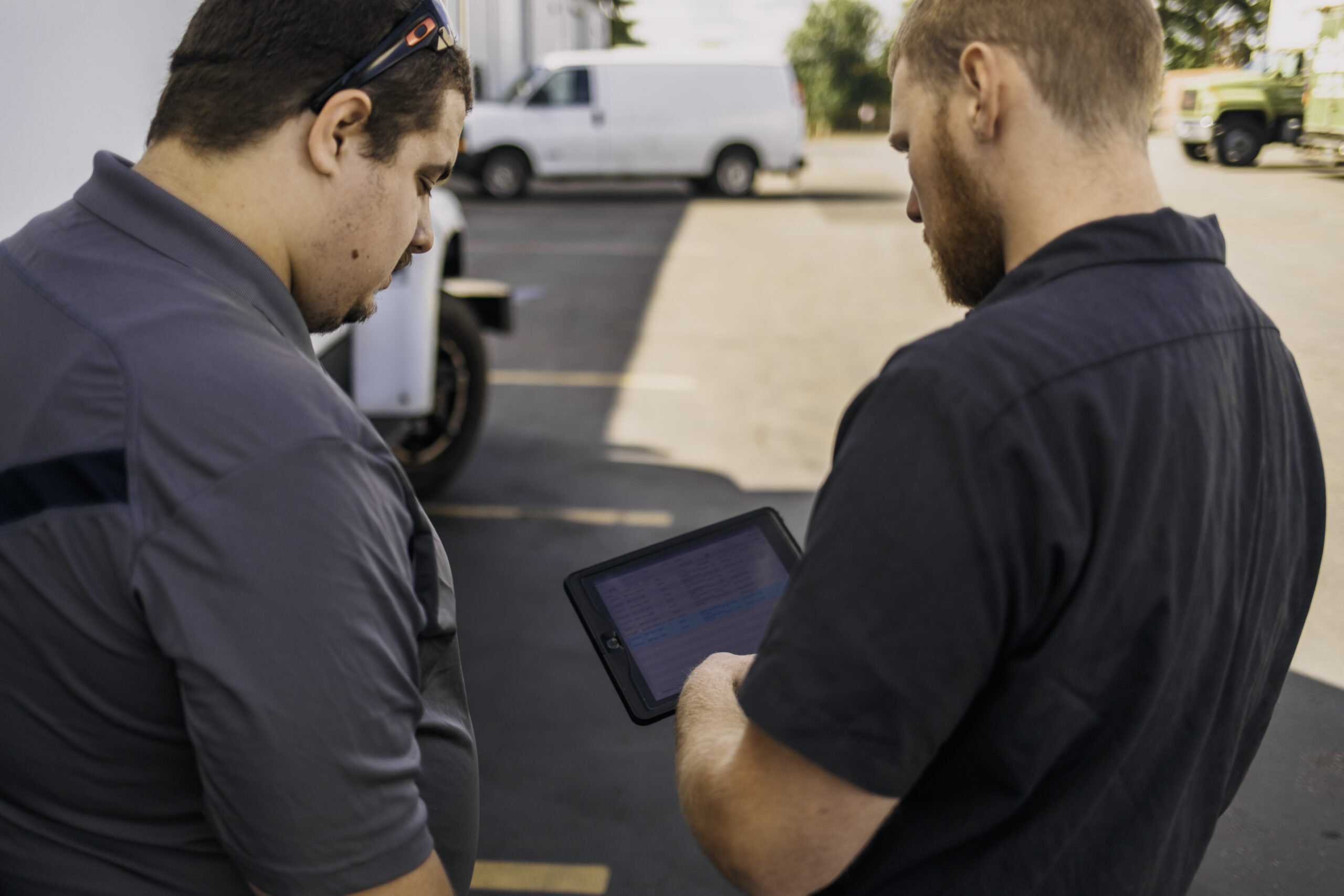
Fleet managers: what’s on your plate these days? We know that running a fleet is an enormous undertaking.
Between building out your trucks’ maintenance schedules and complying with regulations to avoid DOT violations, being a fleet manager is no easy task.
And despite the different balls you’re juggling, remembering to track, analyze, and report on your fleet’s performance is probably lower on your priority list.
Equipment Experts, Inc. is here to make your life a little easier: we’ve researched and compiled a list of 11 different fleet metrics and key performance indicators (KPIs) to give you back precious focus time for running your fleet.
Come along for the journey as we describe the top 11 fleet metrics (and KPIs) every fleet manager should be tracking.

Fleet metrics refer to the data you collect, analyze, and report to measure how effective your fleet management strategy is for your business. You can think of fleet data as your invisible toolkit of resources that help you navigate and make clearer the uncertain roads of your business’ winding journey.
The data you choose to track, analyze, and report is up to you, but what’s most important is that the data you use is meaningful for you and the people you work with.
If KPIs and data don’t mean anything to you and your team, they likely won’t help make your business a profit either.
At their best, though, fleet metrics can help businesses:
Fleet metrics are the fuel for your business’ engine, the battery in the motor, and the water that helps make the fruits of your labor grow. When you use your data correctly, it can help you make actionable decisions that can help you transform your business and take it to new heights.
Wondering what it takes to grow your business with fleet metrics? In the next section, we’ll discuss some of the most beneficial fleet metrics to have in your business’ knapsack.

The following fleet maintenance and repair tracking metrics can help managers make more informed, data-driven decisions for their fleet’s overall performance.
The most common metrics managers track include:
Here’s our breakdown of the 11 fleet metrics and KPIs by category:
1. DVIR reports filed (maintenance metrics)
2. Preventive Maintenance Management metrics (maintenance)
3. Mileage metrics and odometer readings (maintenance)
4. Optimal vehicle replacement metrics (maintenance)
5. Fuel costs and management metrics (Asset metrics)
6. Asset utilization (asset metrics)
7. Parts and inventory (asset metrics)
8. Accidents and safety (human metrics)
9. Driver assignments (human metrics)
10. Technician productivity (human metrics)
11. Performance metrics (human metrics)
We’ll discuss each in more detail in the following sections.

Maintenance metrics refer to your team’s current maintenance strategies, protocols, and action plans regarding vehicle maintenance. You can make data-driven decisions by focusing on DVIR reports filed, preventive maintenance (PM) metrics, mileage metrics, odometer readings, and vehicle replacement.

The first of our fleet management KPIs is about how inspections are carried out at your facility. Driver vehicle inspection reports (DVIR) not only help keep fleets in compliance with DOT authorities but also help with fleet asset utilization.
Tracking fleet metrics like DVIRs can help you notice patterns of issues in your fleet assets. Your fleet can leverage DVIR data by cross-referencing vehicle and user data from inspections to ensure you’re not missing any defects needing repair work in your fleet.
As you begin to notice trends in your fleet’s overall operational efficiency, you can tweak your PM strategy to help reduce the number of hours of vehicle downtime in your fleet. Stay on top of your fleet’s operational costs by tracking the DVIRs filed during asset and vehicle inspections.
A truck’s no good to your business if it keeps breaking down, right? Worst yet, if you continued to invest in a faulty truck, overall driver safety would decrease — both for you and other drivers on the road.
You want to save yourself the hassle of — and repair costs associated with — dealing with angry drivers who were affected by your vehicle’s poor performance.
The best way to improve your fleet’s efficiency and avoid potential problems due to faulty fleet vehicles is by creating a solid preventive maintenance (PM) program that tracks vehicle performance at regular intervals.
For example, you might monitor how often you adhere to your PM schedule. Try aiming for a 95% on-time success rate to ensure fleet efficiency and vehicle uptime.
You’ll greatly improve your fleet’s performance if you and your team stick to a regular PM schedule. For a more improved fleet, analyze fleet metrics such as how often you and your team are on schedule with performing PM.

Most PM metrics identify trends in mileage driven and/or use odometer readings to help identify opportunities for fleet improvement.
You can use odometer readings to help make more informed decisions about managing drivers, the rising cost of fuel, and vehicle conditions.
Consider calculating the cost-per-mile of each of your assets. You can use this information to determine how to optimize your budget and troubleshoot any areas needed to better monitor your company’s performance.
Two helpful fleet management KPIs related to mileage include:
These metrics can help you take measures to reduce complications with drive time. You’ll also be able to use this information to determine which routes and drivers are most profitable for your fleet’s growing needs.
By keeping tabs on the miles you’ve driven, you’ll be able to make more informed decisions about fuel consumption and identify fuel-wasting practices that could hamper your assets’ overall health.
Some repairs may eat away at your budget and prove to be more costly for the long-run. After reviewing your fleet operations, you might decide that it’s time to replace a vehicle.
Keeping tabs on when and how often you replace your vehicle can help you optimize the health of your fleet. If in doubt, don’t hesitate to consult a certified fleet repair technician for additional support.
Fleet operations are only as profitable as their assets are healthy. Asset metrics refer to any type of real-time data analytics from computer systems and fleet management software that can help you track and identify areas for improvement with your fleet operations.
Common asset metrics include fuel management metrics, asset utilization, and parts and inventory used.
While fuel economy has improved with most newer truck models, gas prices haven’t. In fact, gas prices have steadily been climbing over the last 30 or so years.
All the more reason managers everywhere are monitoring how much their companies are spending on fuel. You can track fuel costs to increase efficiency with your fleet by tracking the number of miles per gallon and idle time of your vehicles.
These two metrics can help identify troublesome issues that may be caused by your vehicle or by driver behavior, giving your fleet technicians valuable insights into how to nurture the health of your assets.
Take proactive measures with the upkeep of your vehicles by keeping tabs on the cost of fuel and optimizing fuel usage.
It’s a funky phrase: asset utilization. But this clunky phrase is pretty simple.
It refers to how you use your assets, plain and simple. A fleet manager’s focus is always on maximizing this metric.
By keeping track of metrics such as the average number of hours of use or miles driven per day on a particular asset, you can ensure your fleet continues to adhere to important safety procedures needed to pass regular safety and compliance checks.
After monitoring your assets for a few months, you may even find that certain vehicles are being over or underutilized. Then, you can decide whether your asset should be sold for a profit or repaired for future use.
By monitoring this asset-based metric, you can make sure your fleet operates at maximum efficiency and correct any asset inefficiencies you think need adjustment.
Nothing’s worse than looking in the stock room and finding you’re all out of exactly what your fleet needs for today’s task. You can improve overall fleet performance by tracking needed parts and inventory.
By tracking part usage, you’ll discover which parts are utilized most and least, which contribute to the highest maintenance costs for your business, and how to increase overall fleet performance by having the right parts in stock at the right time of the year.
We recommend reviewing part order histories and tracking inventory at regular intervals throughout the year. By monitoring these metrics, you can make better year-round decisions for the health of your fleet.
The optimization of a fleet doesn’t just involve assets like forklifts and diesel trucks. Your greatest assets to your fleet are the awesome diesel mechanics and drivers you hire and/or partner with.
Advanced fleet management requires not just looking at fleet utilization rates and asset metrics. To create a rock-solid fleet, managers need to monitor human metrics such as accidents, safety inspections, driver assignments, technician productivity, and the performance of their assets.
Another fleet management KPI to monitor is driver behavior, driver training, accidents, and safety incidents that occur while on the job. Ideally, your accident rate should be close to 0%, but alas, accidents happen.
As a fleet manager, your ability to track accidents will help you identify which assets — or driving behaviors — need correction.
For your vehicles, it’s worth pairing a telematics device to determine the most common diagnostic trouble codes appearing on your vehicle. By tracking common faults occurring in assets, you can reduce the number of accidents and safety incidents occurring as a result of vehicle utilization.
If a driver’s behavior is causing the accident, you can determine which driver training programs are needed to correct unsafe driver behaviors. You can improve the cost-effectiveness of your fleet by monitoring the cause and frequency of accidents in your fleet.

If you need to light a fire underneath your drivers’ butts with training programs — which exist, of course, to also improve the value of your fleet — you can track metrics around driver assignments. Fleet metrics — such as the duration and distance of assignments, the driver’s speed, and the quickest routes for payload drop-off and pickup — can help decrease excessive idle time and improve your fleet’s processes.
Most fleet vehicles nowadays are equipped with GPS tracking. You can continue to optimize driver assignments by keeping tabs on routes taken, drive time, and more with your fleet’s preferred GPS telematics device.
The Federal Motor Carrier Safety Administration (FMCSA) requires that every motor carrier inspect, repair, and maintain the vehicles in their care at timely intervals. While there’s no doubt that timely PM care helps improve the life and value of assets, the value of a PM program is defined by the technicians running it.
Fleet optimization also starts by tracking the time it takes to fulfill work orders and maintenance requests. By looking how productive your processes are, you’ll be able to determine how long each vehicle is in the shop, what asset is being worked on, and how long certain jobs take.
With the data you gather, you’ll be able to act accordingly to help maximize your fleet’s value.
After looking at your assets, the people working on them, and the maintenance covered, it’s important to take a step back. Your metrics should ideally include an analysis of the performance of your fleet as a whole — humans, assets, and maintenance plans included.
Whether it’s tracking or budgeting for a healthier fleet, you’ll want to keep ongoing checklists of your fleet vehicles’ performance. By looking at historical data on asset utilization, maintenance, and performance, you’ll have the confidence and knowledge to take action to benefit your fleet.
If you’re looking for a fleet repair facility in the greater Tacoma, Washington area, look no further. We’ve been in the business of fleet repairs, maintenance, and management for more than 20 years.
As a token of our appreciation for reading this article, we’d like to give you a small gift. It’s our 2-minute-or-less fleet manager video series and eBook.
These resources are full of helpful tips and tricks to help create a more profitable, efficient fleet. We’re giving it to you because we want you to feel prepared for wherever the road takes you.
If you’d prefer to speak with someone in person or over the phone about these resources — or with a fleet-related question or comment — feel free to give us a call. We’d be happy to help!
Wherever life takes you, we wish you the best with your fleet.